Employment Law Report: Analysis of Employment Law Principles and Cases
VerifiedAdded on 2022/12/19
|9
|2796
|57
Report
AI Summary
This report provides a comprehensive analysis of employment law, exploring key concepts through case studies. The report begins by examining unfair dismissal, specifically focusing on a case where an employee was terminated after raising safety concerns. It then delves into the doctrine of restraint of trade, discussing its purpose, benefits, and limitations, supported by relevant legal precedents. Finally, the report addresses the employment law consequences of a business transfer under TUPE, offering advice to a new employer on their obligations regarding employee rights, information provision, and potential liabilities. The report also includes references to relevant legislation and legal literature to support its arguments.
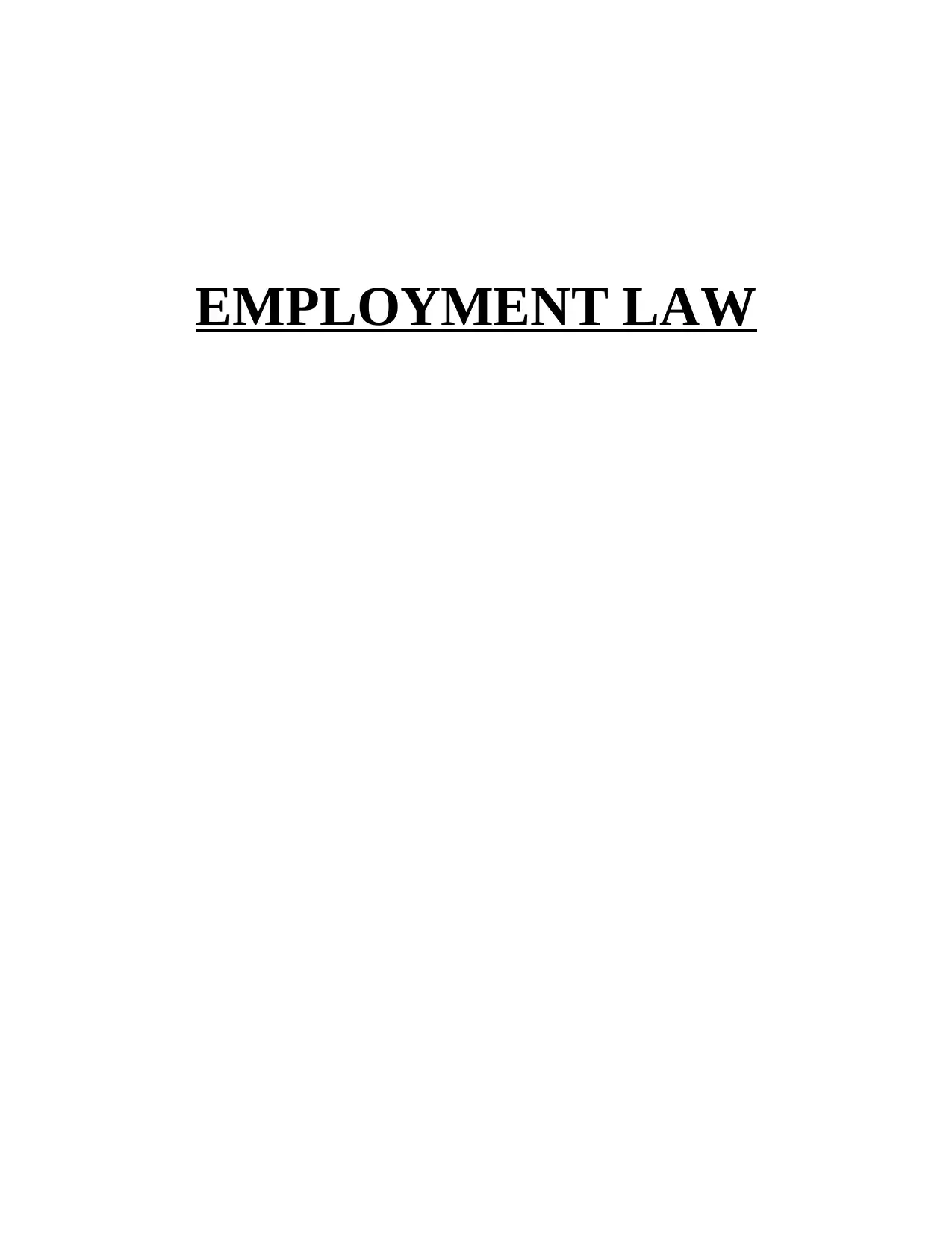
EMPLOYMENT LAW
Paraphrase This Document
Need a fresh take? Get an instant paraphrase of this document with our AI Paraphraser
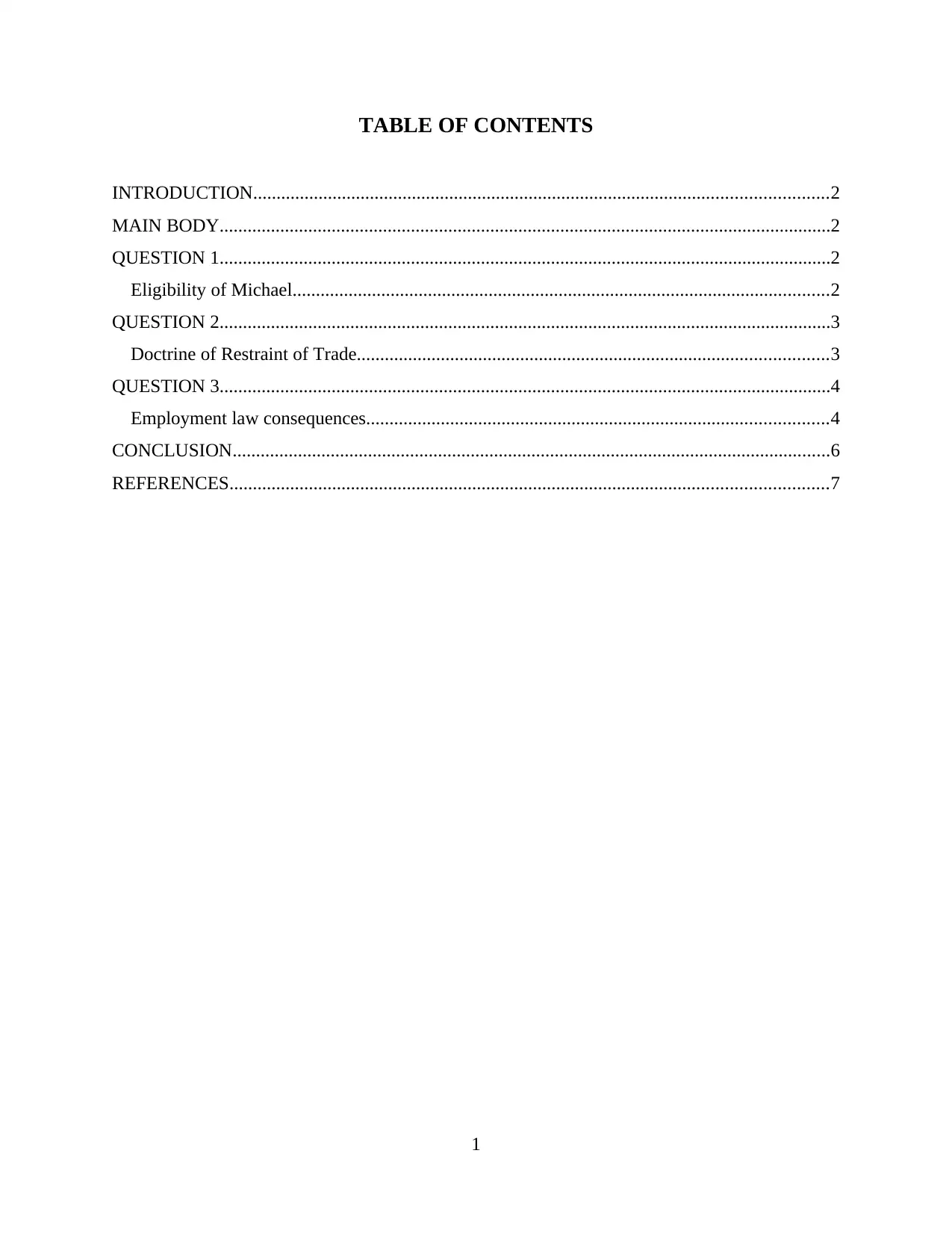
TABLE OF CONTENTS
INTRODUCTION...........................................................................................................................2
MAIN BODY...................................................................................................................................2
QUESTION 1...................................................................................................................................2
Eligibility of Michael...................................................................................................................2
QUESTION 2...................................................................................................................................3
Doctrine of Restraint of Trade.....................................................................................................3
QUESTION 3...................................................................................................................................4
Employment law consequences...................................................................................................4
CONCLUSION................................................................................................................................6
REFERENCES................................................................................................................................7
1
INTRODUCTION...........................................................................................................................2
MAIN BODY...................................................................................................................................2
QUESTION 1...................................................................................................................................2
Eligibility of Michael...................................................................................................................2
QUESTION 2...................................................................................................................................3
Doctrine of Restraint of Trade.....................................................................................................3
QUESTION 3...................................................................................................................................4
Employment law consequences...................................................................................................4
CONCLUSION................................................................................................................................6
REFERENCES................................................................................................................................7
1
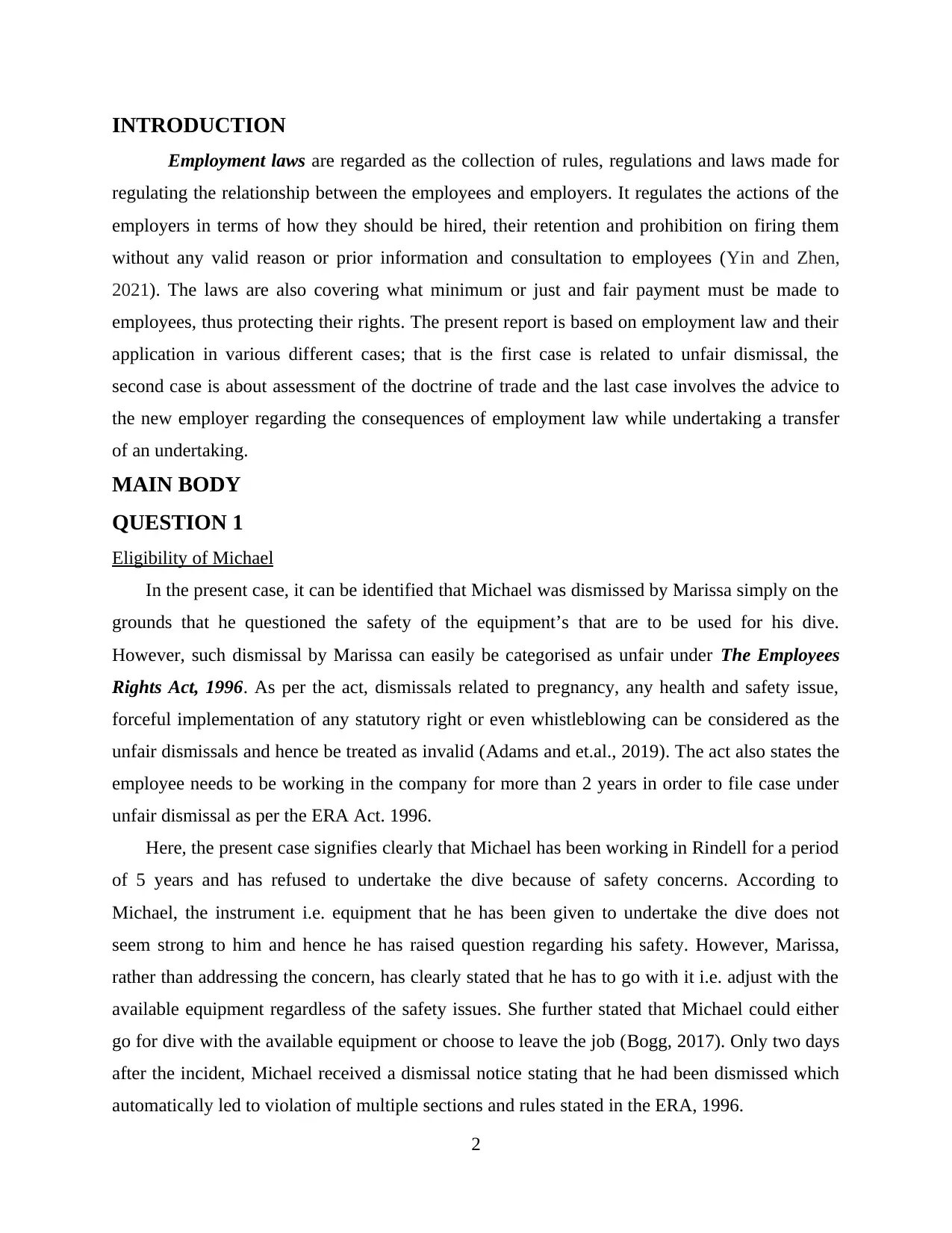
INTRODUCTION
Employment laws are regarded as the collection of rules, regulations and laws made for
regulating the relationship between the employees and employers. It regulates the actions of the
employers in terms of how they should be hired, their retention and prohibition on firing them
without any valid reason or prior information and consultation to employees (Yin and Zhen,
2021). The laws are also covering what minimum or just and fair payment must be made to
employees, thus protecting their rights. The present report is based on employment law and their
application in various different cases; that is the first case is related to unfair dismissal, the
second case is about assessment of the doctrine of trade and the last case involves the advice to
the new employer regarding the consequences of employment law while undertaking a transfer
of an undertaking.
MAIN BODY
QUESTION 1
Eligibility of Michael
In the present case, it can be identified that Michael was dismissed by Marissa simply on the
grounds that he questioned the safety of the equipment’s that are to be used for his dive.
However, such dismissal by Marissa can easily be categorised as unfair under The Employees
Rights Act, 1996. As per the act, dismissals related to pregnancy, any health and safety issue,
forceful implementation of any statutory right or even whistleblowing can be considered as the
unfair dismissals and hence be treated as invalid (Adams and et.al., 2019). The act also states the
employee needs to be working in the company for more than 2 years in order to file case under
unfair dismissal as per the ERA Act. 1996.
Here, the present case signifies clearly that Michael has been working in Rindell for a period
of 5 years and has refused to undertake the dive because of safety concerns. According to
Michael, the instrument i.e. equipment that he has been given to undertake the dive does not
seem strong to him and hence he has raised question regarding his safety. However, Marissa,
rather than addressing the concern, has clearly stated that he has to go with it i.e. adjust with the
available equipment regardless of the safety issues. She further stated that Michael could either
go for dive with the available equipment or choose to leave the job (Bogg, 2017). Only two days
after the incident, Michael received a dismissal notice stating that he had been dismissed which
automatically led to violation of multiple sections and rules stated in the ERA, 1996.
2
Employment laws are regarded as the collection of rules, regulations and laws made for
regulating the relationship between the employees and employers. It regulates the actions of the
employers in terms of how they should be hired, their retention and prohibition on firing them
without any valid reason or prior information and consultation to employees (Yin and Zhen,
2021). The laws are also covering what minimum or just and fair payment must be made to
employees, thus protecting their rights. The present report is based on employment law and their
application in various different cases; that is the first case is related to unfair dismissal, the
second case is about assessment of the doctrine of trade and the last case involves the advice to
the new employer regarding the consequences of employment law while undertaking a transfer
of an undertaking.
MAIN BODY
QUESTION 1
Eligibility of Michael
In the present case, it can be identified that Michael was dismissed by Marissa simply on the
grounds that he questioned the safety of the equipment’s that are to be used for his dive.
However, such dismissal by Marissa can easily be categorised as unfair under The Employees
Rights Act, 1996. As per the act, dismissals related to pregnancy, any health and safety issue,
forceful implementation of any statutory right or even whistleblowing can be considered as the
unfair dismissals and hence be treated as invalid (Adams and et.al., 2019). The act also states the
employee needs to be working in the company for more than 2 years in order to file case under
unfair dismissal as per the ERA Act. 1996.
Here, the present case signifies clearly that Michael has been working in Rindell for a period
of 5 years and has refused to undertake the dive because of safety concerns. According to
Michael, the instrument i.e. equipment that he has been given to undertake the dive does not
seem strong to him and hence he has raised question regarding his safety. However, Marissa,
rather than addressing the concern, has clearly stated that he has to go with it i.e. adjust with the
available equipment regardless of the safety issues. She further stated that Michael could either
go for dive with the available equipment or choose to leave the job (Bogg, 2017). Only two days
after the incident, Michael received a dismissal notice stating that he had been dismissed which
automatically led to violation of multiple sections and rules stated in the ERA, 1996.
2
⊘ This is a preview!⊘
Do you want full access?
Subscribe today to unlock all pages.

Trusted by 1+ million students worldwide
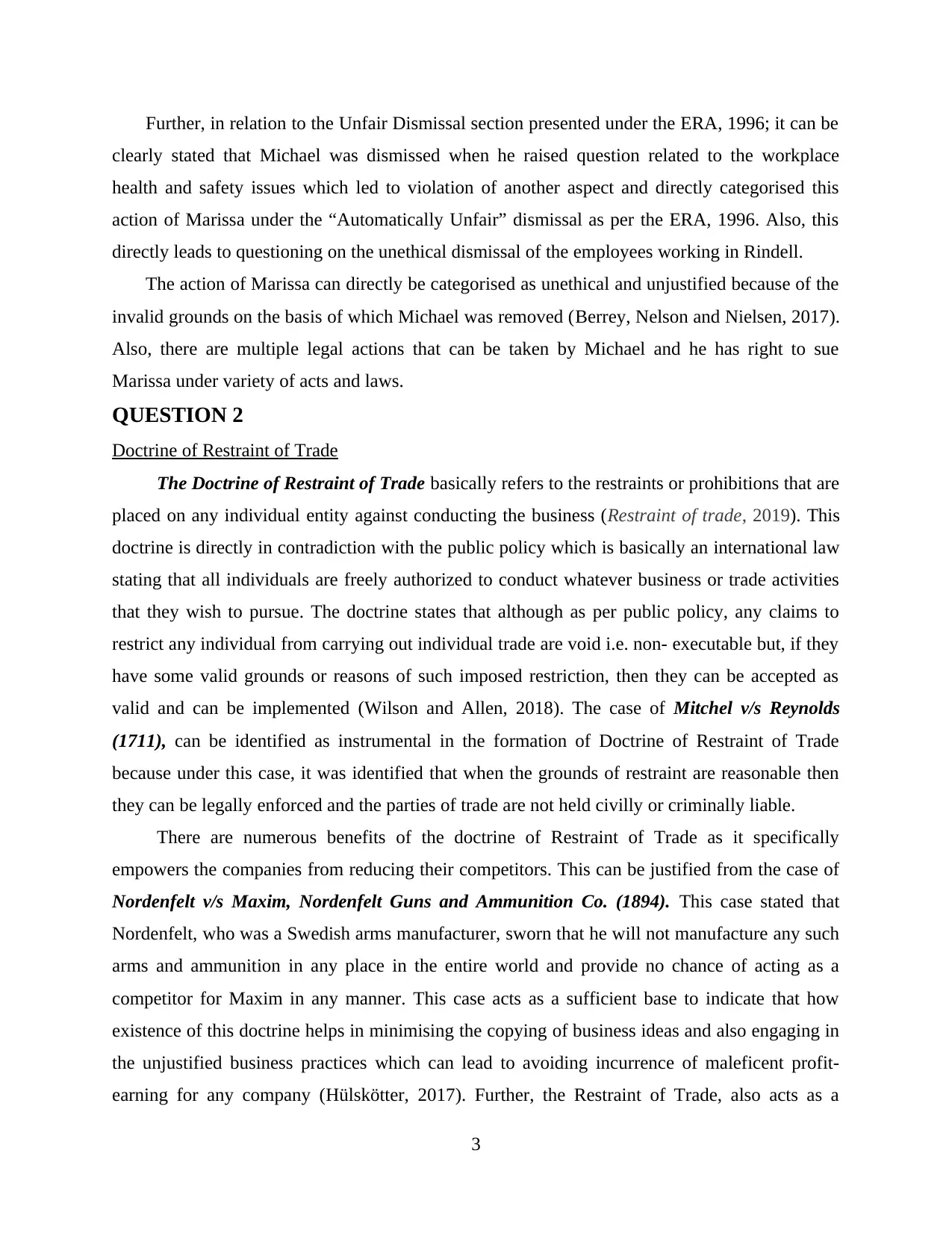
Further, in relation to the Unfair Dismissal section presented under the ERA, 1996; it can be
clearly stated that Michael was dismissed when he raised question related to the workplace
health and safety issues which led to violation of another aspect and directly categorised this
action of Marissa under the “Automatically Unfair” dismissal as per the ERA, 1996. Also, this
directly leads to questioning on the unethical dismissal of the employees working in Rindell.
The action of Marissa can directly be categorised as unethical and unjustified because of the
invalid grounds on the basis of which Michael was removed (Berrey, Nelson and Nielsen, 2017).
Also, there are multiple legal actions that can be taken by Michael and he has right to sue
Marissa under variety of acts and laws.
QUESTION 2
Doctrine of Restraint of Trade
The Doctrine of Restraint of Trade basically refers to the restraints or prohibitions that are
placed on any individual entity against conducting the business (Restraint of trade, 2019). This
doctrine is directly in contradiction with the public policy which is basically an international law
stating that all individuals are freely authorized to conduct whatever business or trade activities
that they wish to pursue. The doctrine states that although as per public policy, any claims to
restrict any individual from carrying out individual trade are void i.e. non- executable but, if they
have some valid grounds or reasons of such imposed restriction, then they can be accepted as
valid and can be implemented (Wilson and Allen, 2018). The case of Mitchel v/s Reynolds
(1711), can be identified as instrumental in the formation of Doctrine of Restraint of Trade
because under this case, it was identified that when the grounds of restraint are reasonable then
they can be legally enforced and the parties of trade are not held civilly or criminally liable.
There are numerous benefits of the doctrine of Restraint of Trade as it specifically
empowers the companies from reducing their competitors. This can be justified from the case of
Nordenfelt v/s Maxim, Nordenfelt Guns and Ammunition Co. (1894). This case stated that
Nordenfelt, who was a Swedish arms manufacturer, sworn that he will not manufacture any such
arms and ammunition in any place in the entire world and provide no chance of acting as a
competitor for Maxim in any manner. This case acts as a sufficient base to indicate that how
existence of this doctrine helps in minimising the copying of business ideas and also engaging in
the unjustified business practices which can lead to avoiding incurrence of maleficent profit-
earning for any company (Hülskötter, 2017). Further, the Restraint of Trade, also acts as a
3
clearly stated that Michael was dismissed when he raised question related to the workplace
health and safety issues which led to violation of another aspect and directly categorised this
action of Marissa under the “Automatically Unfair” dismissal as per the ERA, 1996. Also, this
directly leads to questioning on the unethical dismissal of the employees working in Rindell.
The action of Marissa can directly be categorised as unethical and unjustified because of the
invalid grounds on the basis of which Michael was removed (Berrey, Nelson and Nielsen, 2017).
Also, there are multiple legal actions that can be taken by Michael and he has right to sue
Marissa under variety of acts and laws.
QUESTION 2
Doctrine of Restraint of Trade
The Doctrine of Restraint of Trade basically refers to the restraints or prohibitions that are
placed on any individual entity against conducting the business (Restraint of trade, 2019). This
doctrine is directly in contradiction with the public policy which is basically an international law
stating that all individuals are freely authorized to conduct whatever business or trade activities
that they wish to pursue. The doctrine states that although as per public policy, any claims to
restrict any individual from carrying out individual trade are void i.e. non- executable but, if they
have some valid grounds or reasons of such imposed restriction, then they can be accepted as
valid and can be implemented (Wilson and Allen, 2018). The case of Mitchel v/s Reynolds
(1711), can be identified as instrumental in the formation of Doctrine of Restraint of Trade
because under this case, it was identified that when the grounds of restraint are reasonable then
they can be legally enforced and the parties of trade are not held civilly or criminally liable.
There are numerous benefits of the doctrine of Restraint of Trade as it specifically
empowers the companies from reducing their competitors. This can be justified from the case of
Nordenfelt v/s Maxim, Nordenfelt Guns and Ammunition Co. (1894). This case stated that
Nordenfelt, who was a Swedish arms manufacturer, sworn that he will not manufacture any such
arms and ammunition in any place in the entire world and provide no chance of acting as a
competitor for Maxim in any manner. This case acts as a sufficient base to indicate that how
existence of this doctrine helps in minimising the copying of business ideas and also engaging in
the unjustified business practices which can lead to avoiding incurrence of maleficent profit-
earning for any company (Hülskötter, 2017). Further, the Restraint of Trade, also acts as a
3
Paraphrase This Document
Need a fresh take? Get an instant paraphrase of this document with our AI Paraphraser
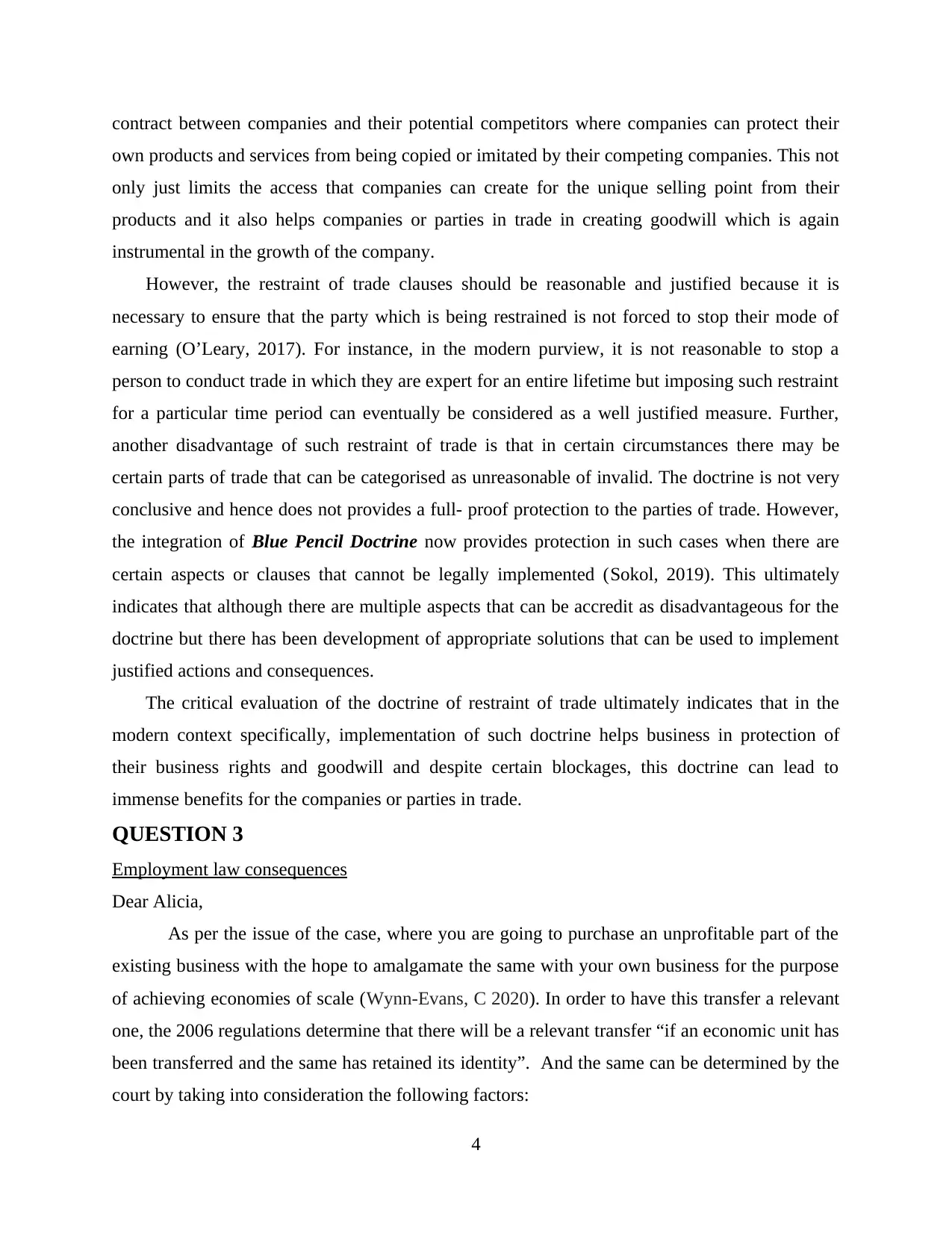
contract between companies and their potential competitors where companies can protect their
own products and services from being copied or imitated by their competing companies. This not
only just limits the access that companies can create for the unique selling point from their
products and it also helps companies or parties in trade in creating goodwill which is again
instrumental in the growth of the company.
However, the restraint of trade clauses should be reasonable and justified because it is
necessary to ensure that the party which is being restrained is not forced to stop their mode of
earning (O’Leary, 2017). For instance, in the modern purview, it is not reasonable to stop a
person to conduct trade in which they are expert for an entire lifetime but imposing such restraint
for a particular time period can eventually be considered as a well justified measure. Further,
another disadvantage of such restraint of trade is that in certain circumstances there may be
certain parts of trade that can be categorised as unreasonable of invalid. The doctrine is not very
conclusive and hence does not provides a full- proof protection to the parties of trade. However,
the integration of Blue Pencil Doctrine now provides protection in such cases when there are
certain aspects or clauses that cannot be legally implemented (Sokol, 2019). This ultimately
indicates that although there are multiple aspects that can be accredit as disadvantageous for the
doctrine but there has been development of appropriate solutions that can be used to implement
justified actions and consequences.
The critical evaluation of the doctrine of restraint of trade ultimately indicates that in the
modern context specifically, implementation of such doctrine helps business in protection of
their business rights and goodwill and despite certain blockages, this doctrine can lead to
immense benefits for the companies or parties in trade.
QUESTION 3
Employment law consequences
Dear Alicia,
As per the issue of the case, where you are going to purchase an unprofitable part of the
existing business with the hope to amalgamate the same with your own business for the purpose
of achieving economies of scale (Wynn-Evans, C 2020). In order to have this transfer a relevant
one, the 2006 regulations determine that there will be a relevant transfer “if an economic unit has
been transferred and the same has retained its identity”. And the same can be determined by the
court by taking into consideration the following factors:
4
own products and services from being copied or imitated by their competing companies. This not
only just limits the access that companies can create for the unique selling point from their
products and it also helps companies or parties in trade in creating goodwill which is again
instrumental in the growth of the company.
However, the restraint of trade clauses should be reasonable and justified because it is
necessary to ensure that the party which is being restrained is not forced to stop their mode of
earning (O’Leary, 2017). For instance, in the modern purview, it is not reasonable to stop a
person to conduct trade in which they are expert for an entire lifetime but imposing such restraint
for a particular time period can eventually be considered as a well justified measure. Further,
another disadvantage of such restraint of trade is that in certain circumstances there may be
certain parts of trade that can be categorised as unreasonable of invalid. The doctrine is not very
conclusive and hence does not provides a full- proof protection to the parties of trade. However,
the integration of Blue Pencil Doctrine now provides protection in such cases when there are
certain aspects or clauses that cannot be legally implemented (Sokol, 2019). This ultimately
indicates that although there are multiple aspects that can be accredit as disadvantageous for the
doctrine but there has been development of appropriate solutions that can be used to implement
justified actions and consequences.
The critical evaluation of the doctrine of restraint of trade ultimately indicates that in the
modern context specifically, implementation of such doctrine helps business in protection of
their business rights and goodwill and despite certain blockages, this doctrine can lead to
immense benefits for the companies or parties in trade.
QUESTION 3
Employment law consequences
Dear Alicia,
As per the issue of the case, where you are going to purchase an unprofitable part of the
existing business with the hope to amalgamate the same with your own business for the purpose
of achieving economies of scale (Wynn-Evans, C 2020). In order to have this transfer a relevant
one, the 2006 regulations determine that there will be a relevant transfer “if an economic unit has
been transferred and the same has retained its identity”. And the same can be determined by the
court by taking into consideration the following factors:
4
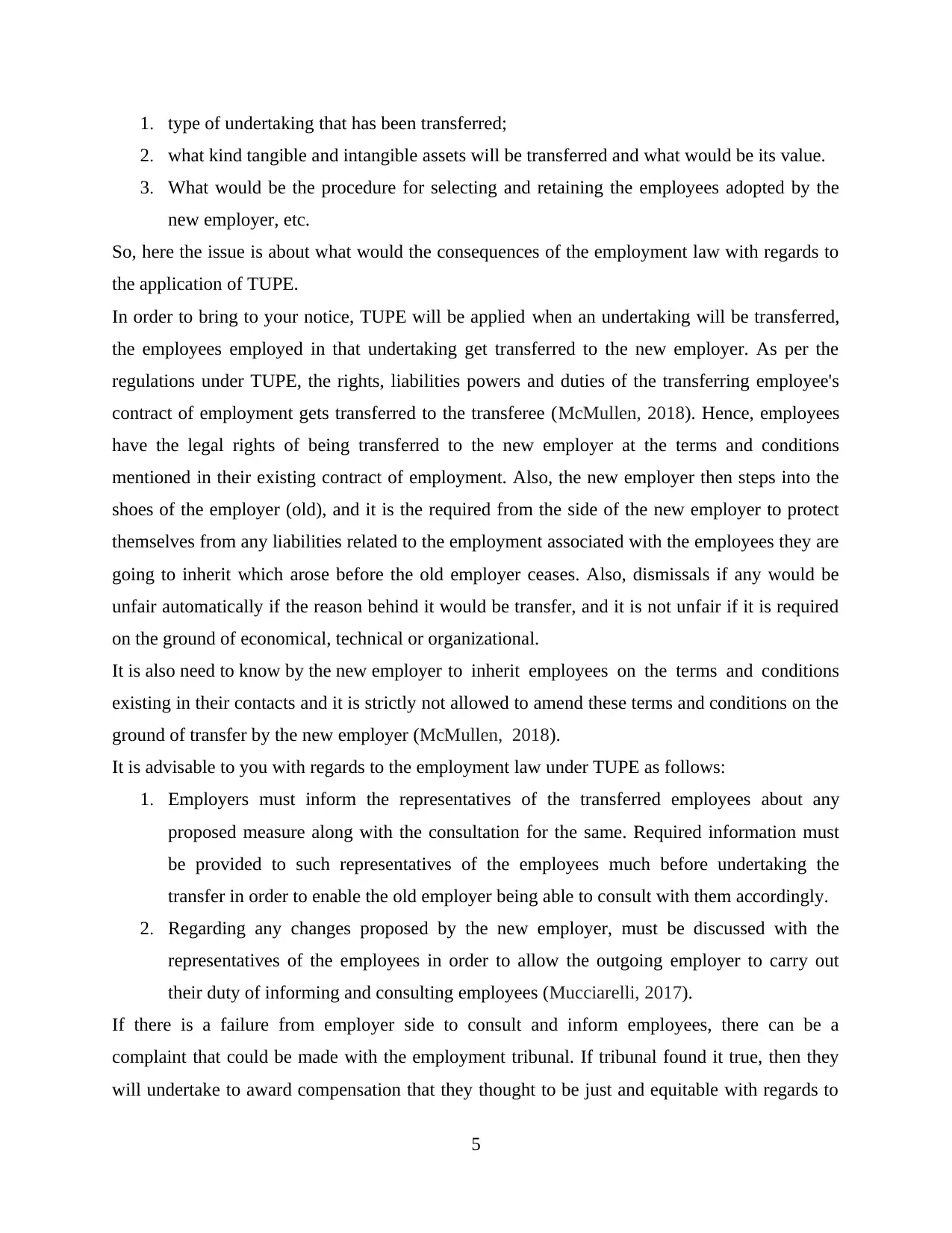
1. type of undertaking that has been transferred;
2. what kind tangible and intangible assets will be transferred and what would be its value.
3. What would be the procedure for selecting and retaining the employees adopted by the
new employer, etc.
So, here the issue is about what would the consequences of the employment law with regards to
the application of TUPE.
In order to bring to your notice, TUPE will be applied when an undertaking will be transferred,
the employees employed in that undertaking get transferred to the new employer. As per the
regulations under TUPE, the rights, liabilities powers and duties of the transferring employee's
contract of employment gets transferred to the transferee (McMullen, 2018). Hence, employees
have the legal rights of being transferred to the new employer at the terms and conditions
mentioned in their existing contract of employment. Also, the new employer then steps into the
shoes of the employer (old), and it is the required from the side of the new employer to protect
themselves from any liabilities related to the employment associated with the employees they are
going to inherit which arose before the old employer ceases. Also, dismissals if any would be
unfair automatically if the reason behind it would be transfer, and it is not unfair if it is required
on the ground of economical, technical or organizational.
It is also need to know by the new employer to inherit employees on the terms and conditions
existing in their contacts and it is strictly not allowed to amend these terms and conditions on the
ground of transfer by the new employer (McMullen, 2018).
It is advisable to you with regards to the employment law under TUPE as follows:
1. Employers must inform the representatives of the transferred employees about any
proposed measure along with the consultation for the same. Required information must
be provided to such representatives of the employees much before undertaking the
transfer in order to enable the old employer being able to consult with them accordingly.
2. Regarding any changes proposed by the new employer, must be discussed with the
representatives of the employees in order to allow the outgoing employer to carry out
their duty of informing and consulting employees (Mucciarelli, 2017).
If there is a failure from employer side to consult and inform employees, there can be a
complaint that could be made with the employment tribunal. If tribunal found it true, then they
will undertake to award compensation that they thought to be just and equitable with regards to
5
2. what kind tangible and intangible assets will be transferred and what would be its value.
3. What would be the procedure for selecting and retaining the employees adopted by the
new employer, etc.
So, here the issue is about what would the consequences of the employment law with regards to
the application of TUPE.
In order to bring to your notice, TUPE will be applied when an undertaking will be transferred,
the employees employed in that undertaking get transferred to the new employer. As per the
regulations under TUPE, the rights, liabilities powers and duties of the transferring employee's
contract of employment gets transferred to the transferee (McMullen, 2018). Hence, employees
have the legal rights of being transferred to the new employer at the terms and conditions
mentioned in their existing contract of employment. Also, the new employer then steps into the
shoes of the employer (old), and it is the required from the side of the new employer to protect
themselves from any liabilities related to the employment associated with the employees they are
going to inherit which arose before the old employer ceases. Also, dismissals if any would be
unfair automatically if the reason behind it would be transfer, and it is not unfair if it is required
on the ground of economical, technical or organizational.
It is also need to know by the new employer to inherit employees on the terms and conditions
existing in their contacts and it is strictly not allowed to amend these terms and conditions on the
ground of transfer by the new employer (McMullen, 2018).
It is advisable to you with regards to the employment law under TUPE as follows:
1. Employers must inform the representatives of the transferred employees about any
proposed measure along with the consultation for the same. Required information must
be provided to such representatives of the employees much before undertaking the
transfer in order to enable the old employer being able to consult with them accordingly.
2. Regarding any changes proposed by the new employer, must be discussed with the
representatives of the employees in order to allow the outgoing employer to carry out
their duty of informing and consulting employees (Mucciarelli, 2017).
If there is a failure from employer side to consult and inform employees, there can be a
complaint that could be made with the employment tribunal. If tribunal found it true, then they
will undertake to award compensation that they thought to be just and equitable with regards to
5
⊘ This is a preview!⊘
Do you want full access?
Subscribe today to unlock all pages.

Trusted by 1+ million students worldwide
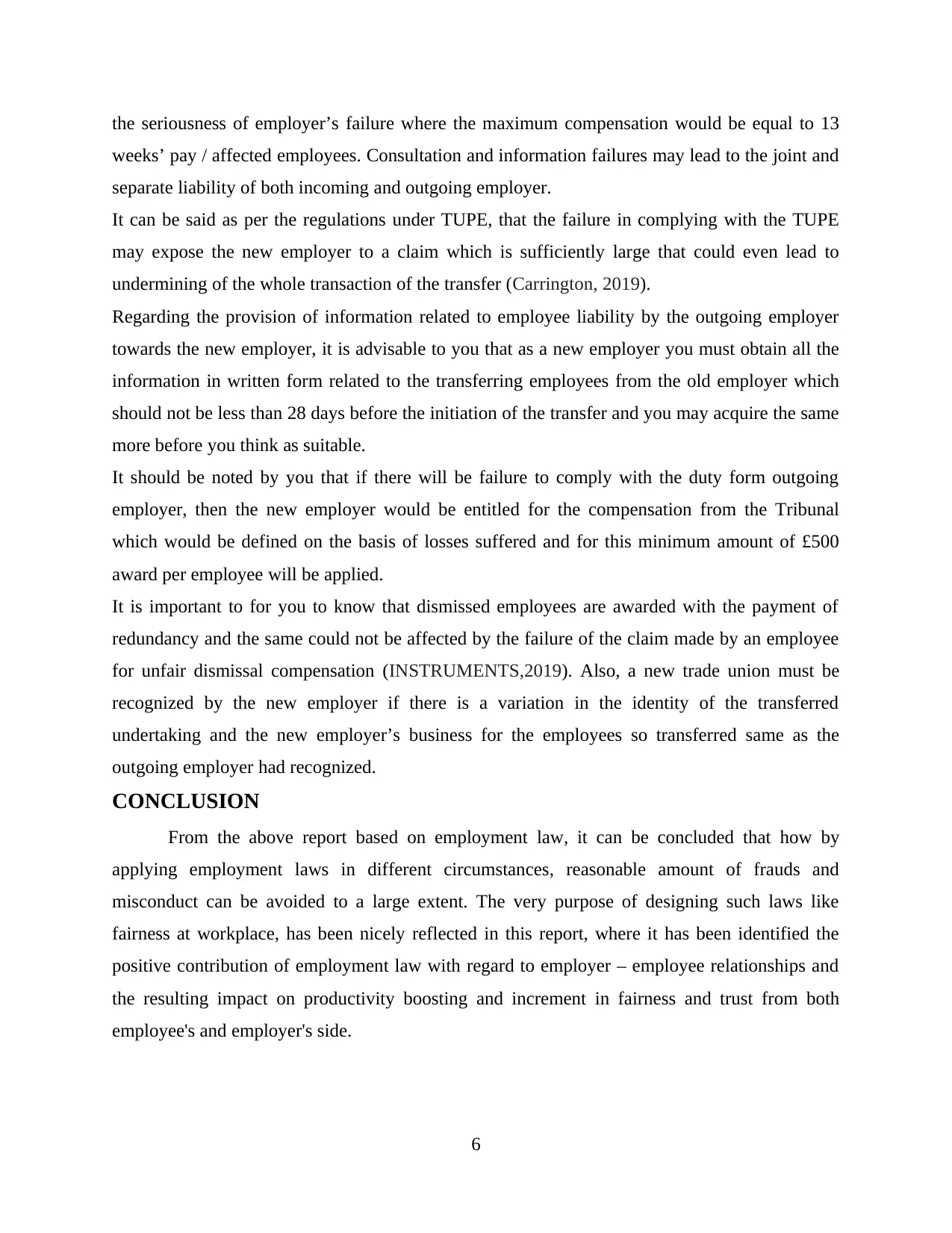
the seriousness of employer’s failure where the maximum compensation would be equal to 13
weeks’ pay / affected employees. Consultation and information failures may lead to the joint and
separate liability of both incoming and outgoing employer.
It can be said as per the regulations under TUPE, that the failure in complying with the TUPE
may expose the new employer to a claim which is sufficiently large that could even lead to
undermining of the whole transaction of the transfer (Carrington, 2019).
Regarding the provision of information related to employee liability by the outgoing employer
towards the new employer, it is advisable to you that as a new employer you must obtain all the
information in written form related to the transferring employees from the old employer which
should not be less than 28 days before the initiation of the transfer and you may acquire the same
more before you think as suitable.
It should be noted by you that if there will be failure to comply with the duty form outgoing
employer, then the new employer would be entitled for the compensation from the Tribunal
which would be defined on the basis of losses suffered and for this minimum amount of £500
award per employee will be applied.
It is important to for you to know that dismissed employees are awarded with the payment of
redundancy and the same could not be affected by the failure of the claim made by an employee
for unfair dismissal compensation (INSTRUMENTS,2019). Also, a new trade union must be
recognized by the new employer if there is a variation in the identity of the transferred
undertaking and the new employer’s business for the employees so transferred same as the
outgoing employer had recognized.
CONCLUSION
From the above report based on employment law, it can be concluded that how by
applying employment laws in different circumstances, reasonable amount of frauds and
misconduct can be avoided to a large extent. The very purpose of designing such laws like
fairness at workplace, has been nicely reflected in this report, where it has been identified the
positive contribution of employment law with regard to employer – employee relationships and
the resulting impact on productivity boosting and increment in fairness and trust from both
employee's and employer's side.
6
weeks’ pay / affected employees. Consultation and information failures may lead to the joint and
separate liability of both incoming and outgoing employer.
It can be said as per the regulations under TUPE, that the failure in complying with the TUPE
may expose the new employer to a claim which is sufficiently large that could even lead to
undermining of the whole transaction of the transfer (Carrington, 2019).
Regarding the provision of information related to employee liability by the outgoing employer
towards the new employer, it is advisable to you that as a new employer you must obtain all the
information in written form related to the transferring employees from the old employer which
should not be less than 28 days before the initiation of the transfer and you may acquire the same
more before you think as suitable.
It should be noted by you that if there will be failure to comply with the duty form outgoing
employer, then the new employer would be entitled for the compensation from the Tribunal
which would be defined on the basis of losses suffered and for this minimum amount of £500
award per employee will be applied.
It is important to for you to know that dismissed employees are awarded with the payment of
redundancy and the same could not be affected by the failure of the claim made by an employee
for unfair dismissal compensation (INSTRUMENTS,2019). Also, a new trade union must be
recognized by the new employer if there is a variation in the identity of the transferred
undertaking and the new employer’s business for the employees so transferred same as the
outgoing employer had recognized.
CONCLUSION
From the above report based on employment law, it can be concluded that how by
applying employment laws in different circumstances, reasonable amount of frauds and
misconduct can be avoided to a large extent. The very purpose of designing such laws like
fairness at workplace, has been nicely reflected in this report, where it has been identified the
positive contribution of employment law with regard to employer – employee relationships and
the resulting impact on productivity boosting and increment in fairness and trust from both
employee's and employer's side.
6
Paraphrase This Document
Need a fresh take? Get an instant paraphrase of this document with our AI Paraphraser
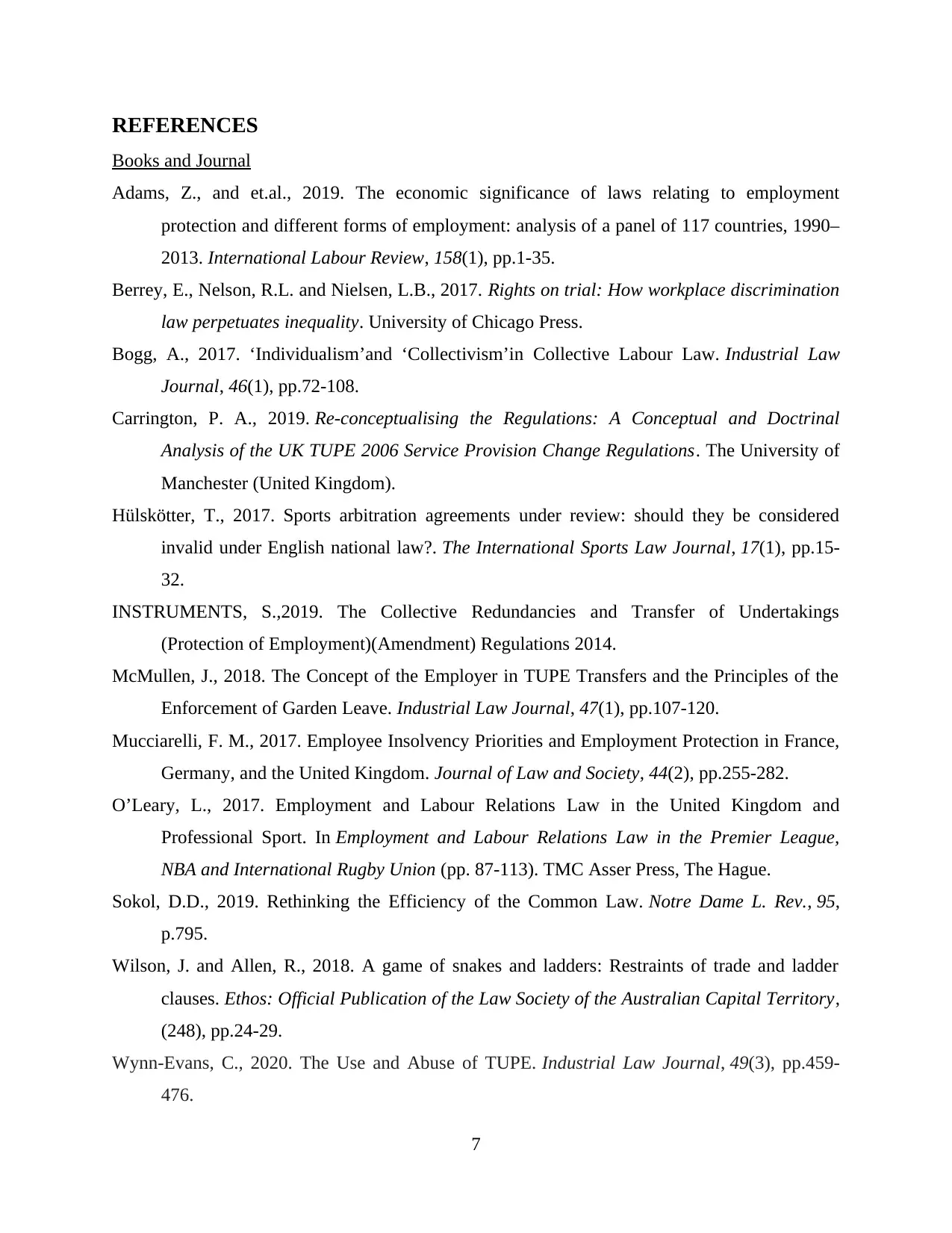
REFERENCES
Books and Journal
Adams, Z., and et.al., 2019. The economic significance of laws relating to employment
protection and different forms of employment: analysis of a panel of 117 countries, 1990–
2013. International Labour Review, 158(1), pp.1-35.
Berrey, E., Nelson, R.L. and Nielsen, L.B., 2017. Rights on trial: How workplace discrimination
law perpetuates inequality. University of Chicago Press.
Bogg, A., 2017. ‘Individualism’and ‘Collectivism’in Collective Labour Law. Industrial Law
Journal, 46(1), pp.72-108.
Carrington, P. A., 2019. Re-conceptualising the Regulations: A Conceptual and Doctrinal
Analysis of the UK TUPE 2006 Service Provision Change Regulations. The University of
Manchester (United Kingdom).
Hülskötter, T., 2017. Sports arbitration agreements under review: should they be considered
invalid under English national law?. The International Sports Law Journal, 17(1), pp.15-
32.
INSTRUMENTS, S.,2019. The Collective Redundancies and Transfer of Undertakings
(Protection of Employment)(Amendment) Regulations 2014.
McMullen, J., 2018. The Concept of the Employer in TUPE Transfers and the Principles of the
Enforcement of Garden Leave. Industrial Law Journal, 47(1), pp.107-120.
Mucciarelli, F. M., 2017. Employee Insolvency Priorities and Employment Protection in France,
Germany, and the United Kingdom. Journal of Law and Society, 44(2), pp.255-282.
O’Leary, L., 2017. Employment and Labour Relations Law in the United Kingdom and
Professional Sport. In Employment and Labour Relations Law in the Premier League,
NBA and International Rugby Union (pp. 87-113). TMC Asser Press, The Hague.
Sokol, D.D., 2019. Rethinking the Efficiency of the Common Law. Notre Dame L. Rev., 95,
p.795.
Wilson, J. and Allen, R., 2018. A game of snakes and ladders: Restraints of trade and ladder
clauses. Ethos: Official Publication of the Law Society of the Australian Capital Territory,
(248), pp.24-29.
Wynn-Evans, C., 2020. The Use and Abuse of TUPE. Industrial Law Journal, 49(3), pp.459-
476.
7
Books and Journal
Adams, Z., and et.al., 2019. The economic significance of laws relating to employment
protection and different forms of employment: analysis of a panel of 117 countries, 1990–
2013. International Labour Review, 158(1), pp.1-35.
Berrey, E., Nelson, R.L. and Nielsen, L.B., 2017. Rights on trial: How workplace discrimination
law perpetuates inequality. University of Chicago Press.
Bogg, A., 2017. ‘Individualism’and ‘Collectivism’in Collective Labour Law. Industrial Law
Journal, 46(1), pp.72-108.
Carrington, P. A., 2019. Re-conceptualising the Regulations: A Conceptual and Doctrinal
Analysis of the UK TUPE 2006 Service Provision Change Regulations. The University of
Manchester (United Kingdom).
Hülskötter, T., 2017. Sports arbitration agreements under review: should they be considered
invalid under English national law?. The International Sports Law Journal, 17(1), pp.15-
32.
INSTRUMENTS, S.,2019. The Collective Redundancies and Transfer of Undertakings
(Protection of Employment)(Amendment) Regulations 2014.
McMullen, J., 2018. The Concept of the Employer in TUPE Transfers and the Principles of the
Enforcement of Garden Leave. Industrial Law Journal, 47(1), pp.107-120.
Mucciarelli, F. M., 2017. Employee Insolvency Priorities and Employment Protection in France,
Germany, and the United Kingdom. Journal of Law and Society, 44(2), pp.255-282.
O’Leary, L., 2017. Employment and Labour Relations Law in the United Kingdom and
Professional Sport. In Employment and Labour Relations Law in the Premier League,
NBA and International Rugby Union (pp. 87-113). TMC Asser Press, The Hague.
Sokol, D.D., 2019. Rethinking the Efficiency of the Common Law. Notre Dame L. Rev., 95,
p.795.
Wilson, J. and Allen, R., 2018. A game of snakes and ladders: Restraints of trade and ladder
clauses. Ethos: Official Publication of the Law Society of the Australian Capital Territory,
(248), pp.24-29.
Wynn-Evans, C., 2020. The Use and Abuse of TUPE. Industrial Law Journal, 49(3), pp.459-
476.
7

Yin, D. and Zhen, X., 2021. Employment Protection and Banking Power: Evidence from
Adoption of Wrongful Discharge Laws. Sustainability, 13(4), p.1635.
Online
Restraint of trade. 2019. [ONLINE]. Available through: <
https://uk.practicallaw.thomsonreuters.com/9-200-3455?
transitionType=Default&contextData=(sc.Default)&firstPage=true>
8
Adoption of Wrongful Discharge Laws. Sustainability, 13(4), p.1635.
Online
Restraint of trade. 2019. [ONLINE]. Available through: <
https://uk.practicallaw.thomsonreuters.com/9-200-3455?
transitionType=Default&contextData=(sc.Default)&firstPage=true>
8
⊘ This is a preview!⊘
Do you want full access?
Subscribe today to unlock all pages.

Trusted by 1+ million students worldwide
1 out of 9
Related Documents
Your All-in-One AI-Powered Toolkit for Academic Success.
+13062052269
info@desklib.com
Available 24*7 on WhatsApp / Email
![[object Object]](/_next/static/media/star-bottom.7253800d.svg)
Unlock your academic potential
Copyright © 2020–2025 A2Z Services. All Rights Reserved. Developed and managed by ZUCOL.




